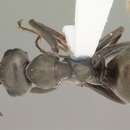Taxonomic History
provided by Antweb
Formica subsericea Say, 1836 PDF: 289 (w.m.) U.S.A. Nearctic.
AntCat AntWiki HOLTaxonomic history
Junior synonym of
Formica fusca:
Mayr, 1886d PDF: 426;
Creighton, 1950a PDF: 532.Revived from synonymy as subspecies of
Formica fusca:
Emery, 1893k PDF: 659;
Buren, 1944a PDF: 300.Revived from synonymy, raised to species and senior synonym of
Formica lecontei:
Francoeur, 1973 PDF: 172.
- bibliographic citation
- AntWeb. Version 8.45.1. California Academy of Science, online at https://www.antweb.org. Accessed 15 December 2022.
Distribution
provided by Catalog of Hymenoptera in America North of Mexico
N. B., Que. s. to Fla. w. to Man., Mont., Iowa, Kans., Mo., Miss.
- bibliographic citation
- Catalog of Hymenoptera in America North of Mexico. 1979. Prepared cooperatively by specialists on the various groups of Hymenoptera under the direction of Karl V. Krombein and Paul D. Hurd, Jr., Smithsonian Institution, and David R. Smith and B. D. Burks, Systematic Entomology Laboratory, Insect Identification and Beneficial Insect Introduction Institute. Science and Education Administration, United States Department of Agriculture.
General Ecology
provided by Catalog of Hymenoptera in America North of Mexico
Occurs in open deciduous woodlands where it nests in the soil under stones or leaf litter; sometimes builds low mounds which may be covered with debris.
- bibliographic citation
- Catalog of Hymenoptera in America North of Mexico. 1979. Prepared cooperatively by specialists on the various groups of Hymenoptera under the direction of Karl V. Krombein and Paul D. Hurd, Jr., Smithsonian Institution, and David R. Smith and B. D. Burks, Systematic Entomology Laboratory, Insect Identification and Beneficial Insect Introduction Institute. Science and Education Administration, United States Department of Agriculture.
Distribution
provided by Catalog of Hymenoptera in America North of Mexico
N. B., Que. s. to Fla. w. to Man., Mont., Iowa, Kans., Mo., Miss.
- bibliographic citation
- Catalog of Hymenoptera in America North of Mexico. 1979. Prepared cooperatively by specialists on the various groups of Hymenoptera under the direction of Karl V. Krombein and Paul D. Hurd, Jr., Smithsonian Institution, and David R. Smith and B. D. Burks, Systematic Entomology Laboratory, Insect Identification and Beneficial Insect Introduction Institute. Science and Education Administration, United States Department of Agriculture.
General Ecology
provided by Catalog of Hymenoptera in America North of Mexico
Occurs in open deciduous woodlands where it nests in the soil under stones or leaf litter; sometimes builds low mounds which may be covered with debris.
- bibliographic citation
- Catalog of Hymenoptera in America North of Mexico. 1979. Prepared cooperatively by specialists on the various groups of Hymenoptera under the direction of Karl V. Krombein and Paul D. Hurd, Jr., Smithsonian Institution, and David R. Smith and B. D. Burks, Systematic Entomology Laboratory, Insect Identification and Beneficial Insect Introduction Institute. Science and Education Administration, United States Department of Agriculture.
Diagnostic Description
provided by Plazi (legacy text)
Formica subsericea, Say , Bost. Journ. Nat. Hist. i. 289,7 [[queen]] [[worker]] [[male]].
Hab. North America (Indiana).
- bibliographic citation
- Smith, F., Catalogue of the hymenopterous insects in the collection of the British Museum. Part VI. Formicidae., pp. -
- author
- Smith, F.
Formica subsericea
provided by wikipedia EN
Formica subsericea, colloquially known as the black field ant, is a species of ant in the genus Formica.[1][2] It is found in the eastern United States and Canada. Workers of this species are incredibly fast and quite timid. Workers of this species are commonly found working as slaves in Polyergus colonies. Nuptial flights typically occur in July or August. It is often confused with another Formica species, Formica fusca.[3] The larvae of Microdon megalogaster, a member of the ant fly genus, have been observed in the nests of these ants. The Inquiline relationship of these fly larvae is not well understood. [4] [5]
References
-
^ Watschke, Thomas L.; Dernoeden, Peter H.; Shetlar, David J. (16 April 2013). Managing Turfgrass Pests, Second Edition. CRC Press. p. 452. ISBN 978-1-4665-5507-5.
-
^ Bolton, B. (2015). "Formica subsericea". AntCat. Retrieved 2 February 2015.
-
^ Francoeur, A. (1973). "Révision taxonomique des espèces néarctiques du groupe fusca, genre Formica (Formicidae, Hymenoptera)". Mémoires de la Société Entomologique du Québec (in French). 3: 1–316.
-
^ Curran, Charles Howard (1925). "Contribution to a monograph of the American Syrphidae north of Mexico". The Kansas University Science Bulletin. 15: 7–216.
-
^ Heiss, Elizabeth Madeleine (1938). "A classification of the larvae and puparia of the Syrphidae of Illinois exclusive of aquatic forms". Series: Illinois biological monographs. 16: 1–142.

- license
- cc-by-sa-3.0
- copyright
- Wikipedia authors and editors
Formica subsericea: Brief Summary
provided by wikipedia EN
Formica subsericea, colloquially known as the black field ant, is a species of ant in the genus Formica. It is found in the eastern United States and Canada. Workers of this species are incredibly fast and quite timid. Workers of this species are commonly found working as slaves in Polyergus colonies. Nuptial flights typically occur in July or August. It is often confused with another Formica species, Formica fusca. The larvae of Microdon megalogaster, a member of the ant fly genus, have been observed in the nests of these ants. The Inquiline relationship of these fly larvae is not well understood.
- license
- cc-by-sa-3.0
- copyright
- Wikipedia authors and editors

